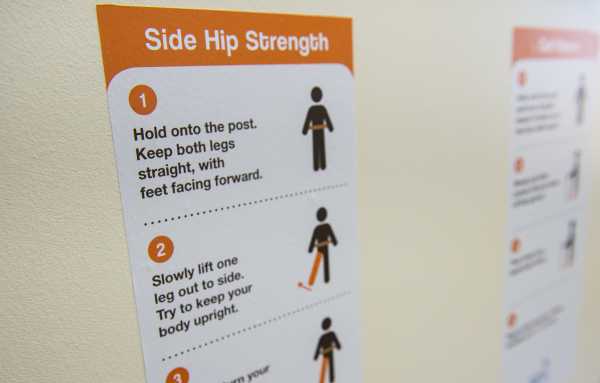Dubbed Exercise Alley, Ward 24 of the Royal Alexandra Hospital (RAH) is displaying a set of stimulating wall stickers which shows how to perform simple exercises to improve strength and balance.
It is the first time the illustrations, newly created by us, have been used in a hospital and they add to a 60m signposted walking circuit already on the ward.
The focus on physical activity is to help patients recover faster, return home sooner and enjoy the physical, mental and social benefits of being active in their community.
Jane Porteous, enhanced recovery nurse said:
Exercise Alley is being put to good use here on Ward 24. Patients who are stepping down from the high dependence unit are encouraged to participate in circuits then progress to adding one or two of the strength and balance exercises to their laps.
“It really is of great benefit to the ward and our patients’ recovery.
Thanks to a partnership between NHS Greater Glasgow and Clyde, Macmillan Cancer Support, Renfrewshire Leisure and Paths for All, Exercise Alley is now part of a physical activity pathway that’s supporting patients before, during and after surgery.
It begins before surgery, with support on improving general health using free physical activity classes.
After surgery, patients are supported on the ward to get mobile as soon as possible. This includes using Exercise Alley to walk more and track their progress, improve muscle strength and coordination by performing exercises on the wall, and encouraging patients to get dressed rather than staying in pyjamas.
On discharge, patients are referred onto Renfrewshire Leisure Community Services which includes group exercise classes and community Health Walks.
Susan Moug, consultant surgeon at the RAH said: “Patients and hospital professionals are now seeing physical activity as an essential part of the surgical pathway. We engage early with our patients at diagnosis, through treatment and into the community, to support them to get more active.
"We continue to work together to ensure what may be a daunting experience is seamless for the patients. In addition to empowering patients to guide their own care - which they like - we believe that increasing activity levels is essential to improve pre-operative, post-operative and long-term outcomes.”
Ruth Miller, Macmillan Service Lead at Renfrewshire Leisure said: “We wanted to offer patients a way to get more exercise on the ward. We had the walking circuit, but we felt there was more we could do. After some discussion, we decided on the dementia friendly strength and balance panels. We didn’t want to over-complicate anything and this was a simple solution.
“Increasing physical activity on the ward speeds up recovery and supports the transition to community activity.”
Daren Borzynski (47) from Dumbarton was a patient in Ward 24 in December 2019 following surgery for a perforated bowel.
Six days after surgery, Daren started taking to his feet, slowly increasing his step count from 1600 to 8000 a day.
Daren said: “One of the things for me was that I wasn’t just sitting dwelling on things, I was getting up and active and enjoying the walks.
“During one of the laps, I noticed the strength and balance stickers. It was a great prompt. It was great to see Paths for All doing this kind of thing in a hospital. The exercises were great. I knew that if I was sitting down for treatment, I could do leg raises at the same time.
“With encouragement from the ward staff, I could feel my health, strength and especially my mental health improving.”
Our simple illustrations, which can be used as indoor wall stickers or outdoors as display panels, show how to perform eight gentle exercises that can improve muscle strength, balance and coordination.

The dementia-friendly design means the graphics can be used by health and social care staff to promote supported and self-led strength and balance activity in a range of settings such as care homes, hospital wards, day centres or public spaces.
Now the charity hopes more health professionals will follow Paisley’s lead and display the illustrations to encourage people to be more active.
Ian Findlay CBE, Chief Officer at Paths for All said: “Doing strength and balance exercises, alongside regular walking, can help you to meet the UK Chief Medical Officers’ Physical Activity Guidelines.
“Awareness of the benefits of regular physical activity is increasing, however there is less knowledge and understanding about the importance of activities that improve muscle strength and balance throughout our adult lives.
“Displaying our illustrations is an effective and easy way to motivate people to perform the exercises everyday and it’s great to see them in the RAH.”
For more information about strength and balance, visit www.pathsforall.org.uk/strength


